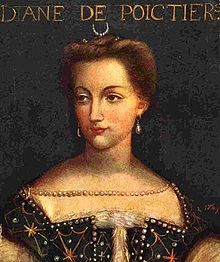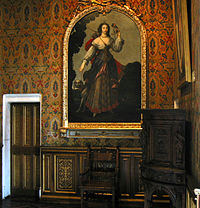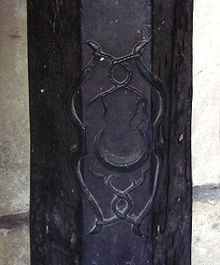- Diane de Poitiers
-
Diane de Poitiers The Grand Senechal(e) of Normandy
Countess of Saint-Vallier
Duchess of Étampes
Duchess of Valentinois
Spouse Louis de Brézé, Seigneur d'Anet Issue Françoise de Brézé
Louise de BrézéFather Jean de Poitiers, Seigneur de Saint Vallier Mother Jeanne de Batarnay Born 3 September 1499
Château de Saint-Vallier, Saint-Vallier, DrômeDied 25 April 1566 (aged 66)
Anet, Eure-et-LoirBurial Château d'Anet, Anet, Eure-et-Loir Diane de Poitiers (3 September 1499 – 25 April 1566) was a French noblewoman and a prominent courtier at the courts of kings Francis I and his son, Henry II of France. She became notorious as the latter's favourite mistress. It was in this capacity that she wielded much influence and power at the French Court, which continued until Henry was mortally wounded in a tournament accident, during which his lance wore her favour (ribbon) rather than his wife's.
She was immortalized in art as the subject of paintings by François Clouet as well as other anonymous painters.
Contents
Early Life and Marriage
She was born the daughter of Jean de Poitiers, Seigneur de Saint Vallier and Jeanne de Batarnay in the Château de Saint-Vallier, in the town of Saint-Vallier, Drôme, in the Rhône-Alpes region of France. When still a girl, she was briefly in the retinue of Anne de Beaujeu, eldest sister of King Charles VIII, a capable and highly intelligent woman who held the regency of France during his minority.
Diane was educated according to the principles of Renaissance humanism which was popular at the time, music, hunting, manners, languages, the art of conversation, and dancing. She learned how to read Latin and Greek, and became a keen hunter and sportswoman, remaining in good physical condition well into middle age.
At the age of fifteen, she married Louis de Brézé, seigneur d'Anet, who was thirty-nine years her senior. He was a grandson of King Charles VII who served as a courtier of King Francis I. She bore him two daughters, Françoise de Brézé (1518–1574) and Louise de Brézé (1521–1577).
In 1524, her father was accused of treason as an accomplice of the rebellious Connétable de Bourbon. His head was already on the execution block when his life was spared by Francis I.
When Louis de Brézé died in 1531 in Anet, Diane adopted the habit of wearing the colours of black and white, her personal trademark for the rest of her life. These were among the permitted colours of mourning, which as a widow she was required to wear, but they were also the symbolic colours of the bright and dark sides of the moon. They played on her name, Diane, which derived from Diana, the name of the beautiful Roman goddess of the moon.
Her keen interest in financial matters and legal shrewdness now became apparent for the first time. She retained her late husband's emoluments as governor and grand-sénéchal of Normandy, assuming herself the title of "sénéchale de Normandie". She challenged in court the obligation to return Louis de Bézé's appanages to the royal domain. The king allowed her to enjoy the appanage's income "until the status of those lands has been totally clarified."
When still the wife of Louis de Brézé, she became lady-in-waiting to Queen Claude de France. After the queen died, she served in the same capacity to Louise de Savoie, then Éléonore de Habsburg.
Life as a Royal Favourite
After the capture of Francis I by Charles V's troops during the battle of Pavia (1525), the two eldest princes, François and Henri, were retained as hostages in Spain in exchange for their father. Because the ransom was not paid in time, the two boys (eight and seven at the time) had to spend nearly four years isolated in a bleak castle, facing an uncertain future. Henri found solace by reading the knight-errantry tale Amadis de Gaula. The experience may account for the strong impression that Diane made on him, as the very embodiment of the ideal gentlewomen he read about in Amadis. As his mother was already dead, Diane gave him the farewell kiss when he was sent to Spain. When he was returned to France at the age of 12, she was ordered by Francis I to act as a mentor to him and teach him courtly manners. At the tournament held for the coronation of Francis's new wife Eleanor in 1531, while the dauphin François saluted the new queen as expected, Henri addressed his salute to Diane.
In 1533 the future Henri II married Catherine de' Medici. There had been strong opposition to this alliance, the Medicis being no more than upstarts in the eyes of many in the French court. Diane, however, approved of this choice of bride. Diane and Catherine were actually related to one another, being both descendants of the La Tour d'Auvergne family.[1] Indeed, to Catherine, Diane was an intrusive elder cousin as well as a rival. As the future royal couple remained childless, concerned by rumours of a possible repudiation of a queen she had in control, Diane made sure that Henri's visits to his wife's bedroom would be frequent. In another act of preservation of the royal family, Diane helped nurse Catherine back to health when she contracted scarlet fever.[2] Diane was in charge of the education of her and Henri's children until 1551; her daughter Françoise managed the queen's servants. While Henri and Catherine would eventually produce 10 children together, and despite the occasional affair,[3] Diane de Poitiers would remain Henri's lifelong companion, and for the next 25 years she would be the most powerful influence in his life.[citation needed] Based on allusions in their correspondence, it is generally believed that she became his mistress in 1538.
Remembered as a beautiful woman, she maintained her good looks well into her 50s, and her appearance was immortalized in art. Only two signed paintings by François Clouet are known to exist, one being a painting of Diane. The subject of that painting shows her seated nude in her bath. She sat for other paintings of the time, often topless or nude, other times in traditional poses.
When Francis I was still alive, Diane had to compete at the court with Anne de Pisseleu, the king's favourite. She had the latter exiled on her lands upon Francis I's death in 1547.
Diane possessed a sharp intellect and was so politically astute that King Henri II trusted her to write many of his official letters, and even to sign them jointly with the one name HenriDiane. Her confident maturity and loyalty to Henri II made her his most dependable ally in the court. Her position in the Court of the King was such that when Pope Paul III sent the new Queen Catherine the "Golden Rose", he did not forget to present the royal mistress Diane with a pearl necklace. Within a very short stretch of time she wielded considerable power within the realm. In 1548 she received the prestigious title of Duchess of Valentinois, then in 1553 was made Duchesse d'Étampes.[4] The king's adoration for Diane caused a great deal of jealousy on the part of Queen Catherine, particularly when Henri entrusted Diane with the Crown Jewels of France, had the Château d'Anet built for her, and gave her the Château de Chenonceau, a piece of royal property that Catherine had wanted for herself. However, as long as the king lived, the Queen was powerless to change this.[4]
Henry's Death and her Downfall
 Portrait of Diane de Poitiers as Diana goddess of the hunt on display in the bedroom of Francis I at the Château de Chenonceau.
Portrait of Diane de Poitiers as Diana goddess of the hunt on display in the bedroom of Francis I at the Château de Chenonceau.
Despite wielding such power over the king, Diane's status depended on the king's welfare, and his remaining in power. In 1559, when Henri was critically wounded in a jousting tournament, Queen Catherine de' Medici assumed control, restricting access to him. Although the king was alleged to have called out repeatedly for Diane, she was never summoned or admitted, and on his death, she was also not invited to the funeral. Immediately thereafter, Catherine de' Medici banished Diane from Chenonceau to the Château de Chaumont. She stayed there only a short time, and lived out her remaining years in her chateau in Anet, Eure-et-Loir, where she lived in comfortable obscurity.
She died at the age of sixty-six. In accordance with her wishes, and to provide a resting place for her, her daughter completed the funeral chapel built near the castle. During the French Revolution, her tomb was opened and her remains thrown into a mass grave.
In 1866 Georges Guiffrey published her correspondence.
When French experts dug up the remains of Diane de Poitiers in 2009, they found high levels of gold in her hair. It is suggested that the "drinkable gold" she regularly took — believed to preserve youth — may have ultimately killed her.[5][6]
In Fiction and Film
Diane de Poitiers has appeared in many novels and films.
Novels:
- The Two Dianas, Alexandre Dumas, père.
- Courtesan, Diane Haeger.
- La Princesse de Clèves, Madame de La Fayette.
- The Devil's Queen: A Novel of Catherine de Medici, Jeanne Kalogridis.
- Queen's Play and Checkmate, Dorothy Dunnett.
Biography:
- The Serpent and the Moon, Princess Michael of Kent.[7]
Films:
- Diane (1956), played by Lana Turner.
- Nostradamus (1994), played by Diane Quick.
References
- ^ Catherine's maternal grandfather was Diane's paternal grandmother's brother.
- ^ Farquhar, Michael (2001). A Treasure of Royal Scandals, p.8. Penguin Books, New York. ISBN 0739420259.
- ^ Philippa Duci, Janet Fleming, Nicole de Savigny
- ^ a b Cultural Tourism web site
- ^ "Henry II’s mistress returned to righful resting place", May 31, 2010, The Sunday Times
- ^ "Fatal Alchemy", 2009 video from BMJ
- ^ It is interesting to note that Princess Michael is a remote descendant of Diane de Poitiers; Diane is Princess Michael's great14-grandmother.
Books
- The Serpent and the Moon: Two Rivals for the Love of a Renaissance King, by Princess Michael of Kent
- Diane de Poitiers, by Ivan Cloulas
- Courtesan, by Diane Haeger (fictional)
- Diane de Poitiers, by Barbara Cartland (N.B. Despite this being by Barbara Cartland, it is not a work of fiction.)
- Madame Serpent, by Jean Plaidy
- The Devil's Queen: A Novel of Catherine de Medici by Jeanne Kalogridis
External Links
Categories:- Duchesses of Valentinois
- 1499 births
- 1566 deaths
- People from Drôme
- Mistresses of French royalty
- House of Valois
- French ladies-in-waiting
- House of Bourbon
- Duchesses of Étampes
Wikimedia Foundation. 2010.




